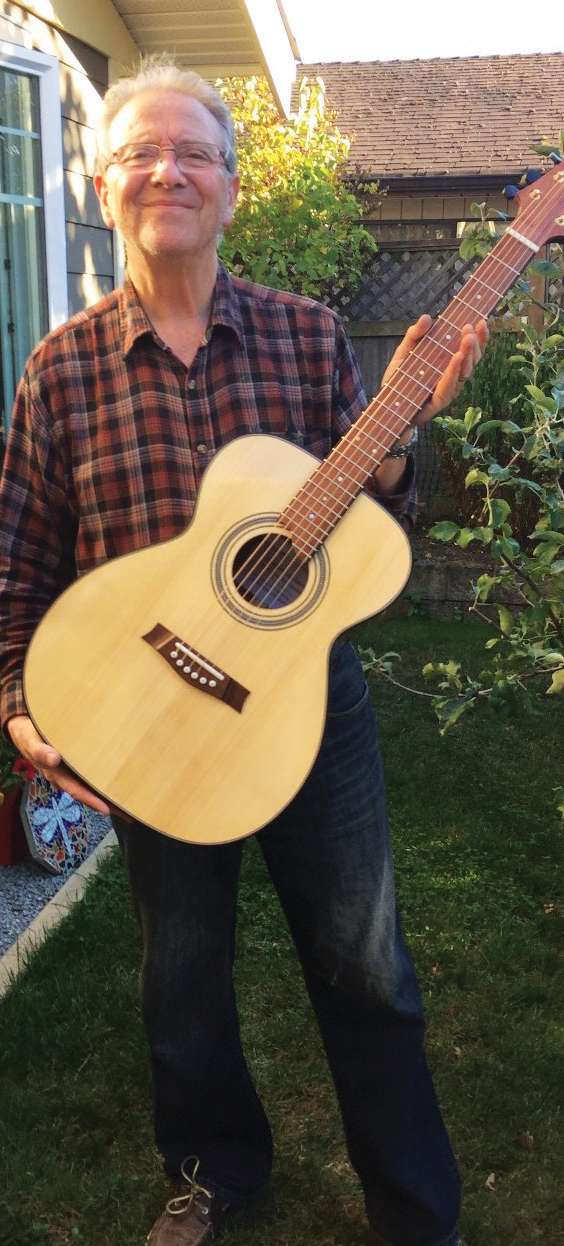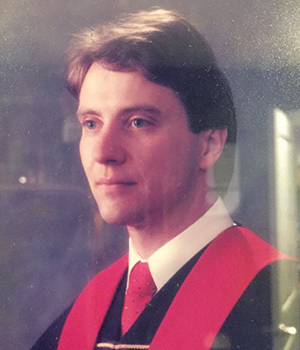Dr Terry Meadows: The dreams and decisions that shaped a life
“To accomplish great things, we must not only act, but also dream; not only plan, but also believe.”
—Anatole France
This quote inspired the author to reflect on the unique journey that Dr Meadows has traveled since he began it in Prince George in 1952.
 Dr Terry Meadows is one of my heroes. I am proud of him: proud of the example he offers, quietly, of following a dream, of working hard to achieve it, of committing to do his best, be it advising others about their health, comforting someone who is dying, being a great dad and husband, growing his own vegetables, making furniture, building guitars. . . the list goes on. He is modest, well read, compassionate, knowledgeable on a variety of topics, and guided by his faith. He has worked for years as a highly skilled family physician, his last assignment as a consultant in the Victoria Cancer Clinic. His story, which is still being written, has inspired me; I know it will inspire you as well.
Dr Terry Meadows is one of my heroes. I am proud of him: proud of the example he offers, quietly, of following a dream, of working hard to achieve it, of committing to do his best, be it advising others about their health, comforting someone who is dying, being a great dad and husband, growing his own vegetables, making furniture, building guitars. . . the list goes on. He is modest, well read, compassionate, knowledgeable on a variety of topics, and guided by his faith. He has worked for years as a highly skilled family physician, his last assignment as a consultant in the Victoria Cancer Clinic. His story, which is still being written, has inspired me; I know it will inspire you as well.
Terry began life in Prince George, born into a family with little material wealth. There were no frills in his home. Life was simple. He learned early to work hard. His affinity for working with wood emerged when he learned how to make toys, guided by his father and grandfather, and moved to building soapbox cars at age 13. He was an enthusiastic participant in soapbox derbies, and gained sponsorship from a Prince George tire company. Over 3 years, he designed and built three increasingly efficient and sophisticated versions of his soapbox cars. He won his local derby in Prince George and eventually placed second at the Western Canada Championship races in Mission. Throughout secondary school, Terry’s dream grew into wanting to train for formula racing. To raise the funds needed to reach his goal, he delivered papers, worked 7 days a week at a local gas station while attending school, and later worked in Prince George pulp mills.
At age 18, after completing high school, he headed to Norfolk, England, to attend the Jim Russell Car Racing School, where he learned to drive and race Formula Fords. During spring and summer months, he worked on construction sites to support his goal of becoming a successful racing car driver. During the winters, Terry returned to Prince George to work in pulp and lumber mills in order to purchase and race his own Formula Ford in Britain. He continued crossing the Atlantic over 5 years to financially support his racing dream.
On one of these occasions, the Prince George mill administrator invited Terry to write an aptitude test with the possibility of training to become a maintenance supervisor at the mill. Terry scored very high and was offered the position; however, he chose instead to continue pursuing his racing dream.
The subsequent 4 years of racing were challenging. The Formula Ford he had purchased had a faulty design—when Terry started working for the race car builder, he identified a basic problem with suspension geometry that made the car’s handling unpredictable. Additionally, with time, it became apparent that he was missing two crucial ingredients in his quest to become a racing professional: money and talent. Finally, after the racing death of a close comrade, Terry decided that he needed a new direction in life.
Initially, Terry returned to the construction trades. With encouragement from friends and his church community, and his own realization that he loved to work with his hands as well as his mind, he started thinking about applying to dental or medical school, and began the long trek to get the med school prerequisite courses under his belt. He studied at the College of New Caledonia for 2 years, again supporting himself by working at a local lumber mill, and was then accepted into third-year honors human physiology at UBC. When it came time to apply to medical school, he passed his MCAT on the first try and began his medical studies in earnest.
“A dream doesn’t become reality through magic; it takes sweat, determination and hard work.”
—Colin Powell
Terry certainly lived this quote. He graduated with an MD in 1985, then headed to Quesnel as a resident in the newly minted UBC Rural Family Practice Residency Program and did rotations in obstetrics and pediatrics in Kelowna. He spent 3 years there, honing his skills as a locum physician and doing ER work. In 1989, Terry purchased a practice in Brentwood Bay on Vancouver Island, where he worked the full gamut of a family medical practice for the next few years. In 1993, he bought an old house in the area, renovated it, and turned it into a neighborhood walk-in clinic as well as a home for his family practice. He was based there until 2006 when he began to do rural locums in communities such as Fort St. James, Port McNeill, and Tofino. During this time, Terry took courses in palliative care, which he put to compassionate use in the Victoria Cancer Clinic, caring for patients on the wards and supporting their families.
Terry recently retired from this position and has embarked on another interest, building the most exquisite guitars. His affinity for guitars began at age 16, when he, like many young people, strummed a guitar to Eric Clapton and the Beatles. He also studied classical and flamenco guitar for a time with a teacher in Prince George.
Terry considers the work of building guitars to be a science and an art. Art determines the grain and the color selections of the wood (wood is appropriate for its sonic qualities). Engineering principles are applied to the construction of some of the shapes of the instrument and how it is otherwise adorned. With every instrument he builds, there are problems to solve, which can be intellectually challenging, yet creating a musical instrument from raw wood is also immensely satisfying. He loves the hours he now spends in his workshop each day.
Terry loved practising medicine and still misses the intellectual stimulation and camaraderie of his colleagues, but he does not miss the stress and pressure that was often involved. His family, faith, being able to spend more time outdoors and in the garden, as well as his interest in music and building guitars, are helping him transition to this new chapter. He encourages young physicians to continue to build and maintain ties to family and friends, and to keep up with interests outside of medicine. For those physicians thinking of retiring, he acknowledges that it may be hard, but it is wonderful to realize that there is another world out there and that, ultimately, a person’s identity is not tied up with what they do for a living.
Terry Meadows lives in Saanichton with his wife, Robin, and daughter, Rachel. His son, Ben, is away at university.
 |
 |
| Taken at racing school in Snetterton, England, 1976. | Terry’s graduation photo, UBC Medical School, 1985. |
hidden
This article has been peer reviewed.
 |
| This work is licensed under a Creative Commons Attribution-NonCommercial-NoDerivatives 4.0 International License. |
hidden
Ms Spicer has been a faculty associate at UBC and SFU in the faculties of education, teacher training. She has volunteered in Cuba since 2001 almost every year and spent 2017–18 as a volunteer teacher trainer in Ghana. She has also produced educational resources on teaching through the arts as well as on gender equity. Dr Meadows is her brother-in-law.

FP, like yourself, needs to have other life interests besides constantly updating.